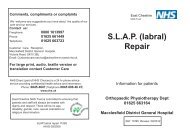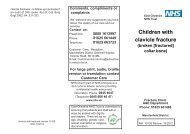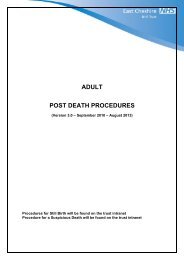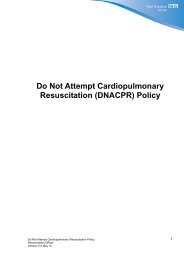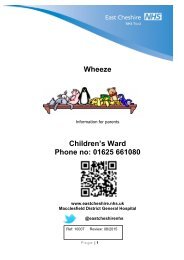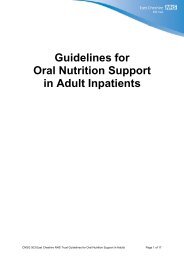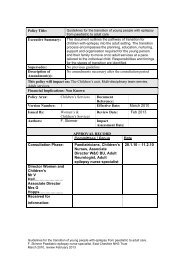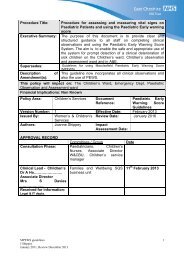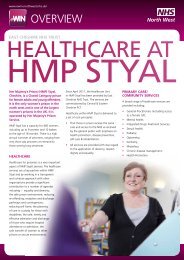Diabetes guidance 1766.pdf - East Cheshire NHS Trust
Diabetes guidance 1766.pdf - East Cheshire NHS Trust
Diabetes guidance 1766.pdf - East Cheshire NHS Trust
Create successful ePaper yourself
Turn your PDF publications into a flip-book with our unique Google optimized e-Paper software.
Insulin therapy - continuedPatients with type 2 <strong>Diabetes</strong> where either a decision to initiate insulin therapy has been made ora change of treatment is indicated.Scenario 1 such as a working middle aged maleThe patient has a relatively set daily routine including meal and work time. HbA1c is greater than69mmol/mol Hb.• Oral agents, especially Metformin and / or pioglitazone, are to be continued unless there is a significantreason to stop them.• Start a biphasic NPH human insulin, such as Humulin M3 or Insuman 25, in a twice a day regimen andadjust doses according to the need.• If there is failure to achieve the target HbA1c after a period of 6 months and/or frequent hypoglycaemicepisodes (especially pre-prandial) and/or post prandial glycaemic excursions are unacceptably high and/orpatient’s eating and/or work patterns become erratic consider a comprehensive Practice Nurse / DSN anddietitian review of lifestyle, exercise, weight and diet before altering the choice of insulin.• If there is no improvement consider a biphasic analogue insulin like Novomix 30 or Humalog Mix25 in atwice a day regimen. If there is repeated failure to achieve HbA1c target or further problems considerfurther DSN review prior to a further change of therapy.• Finally consider a basal bolus regimen.Scenario 2 such as a sight impaired lady in her 70’sThe Patient is on maximum tolerated oral therapy but the HbA1c is above the one set for the individual soinitiation of insulin is indicated. Patient lives alone and/or requires someone to do his/her insulin injection andthere is risk of overnight hypoglycaemic episodes and/or otherwise patient would need a twice a day insulinregimen with either an isophane / NPH insulin or biphasic insulin.• Start once daily analogue basal insulin and adjust dose as needed.• Continue all oral agents unless there is a reason to alter them.• Review the situation with other insulin therapy options if there is failure to achieve the targets or anychange in the individual’s circumstances.Scenario 3 such as a shift worker in their 40’sThe patient has ‘poor’ glycaemic control with HbA1c greater than 69mmol/mol Hb and has erratic meals,meal times and work pattern that is difficult to change or the patient has to inject just before a meal andthe patient’s glycaemic control is ‘very poor’ (HbA1c greater than 86mmol/mol Hb).• Start with a comprehensive review of diet, lifestyle and weight by a Practice Nurse/Dietitian/DSN.• Start a basal bolus regimen with analogue mealtime insulin (like Novorapid or Humalog or Apidra) at eachmeal and a basal insulin (like detemir or glargine) once a day.• A basal bolus regimen with human mealtime short acting insulin (like Humulin S) with each meal and abasal human insulin ( Humulin I, Insulatard or Insuman ) may be considered in exceptional situationswhere there is a strong reason to do so. Usually this group of patients need a basal bolus regimen withanalogue insulin.• Adjust doses as needed.• Oral agents especially Metformin and / or pioglitazones are to be continued unless there is a significantreason to stop them. Ideally, all insulin secretogogues should be stopped with any basal bolus regimenunless there is a compelling reason to leave them on.





